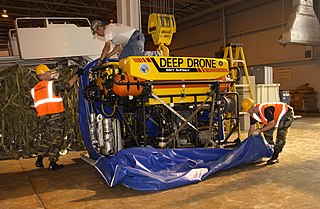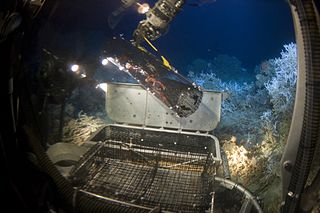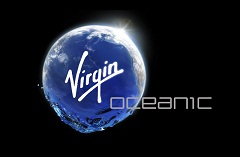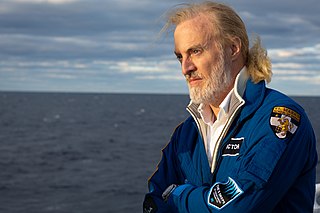
The Mariana Trench or Marianas Trench is located in the western Pacific Ocean about 200 kilometres (124 mi) east of the Mariana Islands; it is the deepest oceanic trench on Earth. It is crescent-shaped and measures about 2,550 km (1,580 mi) in length and 69 km (43 mi) in width. The maximum known depth is 10,984 metres (36,037 ft) at the southern end of a small slot-shaped valley in its floor known as the Challenger Deep. However, some unrepeated measurements place the deepest portion at 11,034 metres (36,201 ft). If Mount Everest were hypothetically placed into the trench at this point, its peak would still be underwater by more than two kilometres (1.2 mi).

A submersible is a small watercraft designed to operate underwater. The term submersible is often used to differentiate from other underwater vessels known as submarines, in that a submarine is a fully autonomous craft, capable of renewing its own power and breathing air, whereas a submersible is usually supported by a surface vessel, platform, shore team or sometimes a larger submarine. In common usage by the general public, however, the word submarine may be used to describe a craft that is by the technical definition actually a submersible. There are many types of submersibles, including both crewed and uncrewed craft, otherwise known as remotely operated vehicles or ROVs. Submersibles have many uses worldwide, such as oceanography, underwater archaeology, ocean exploration, adventure, equipment maintenance and recovery, and underwater videography.

The Scaled Composites Model 311 Virgin Atlantic GlobalFlyer is an aircraft designed by Burt Rutan in which Steve Fossett first flew a solo nonstop airplane flight around the world in slightly more than 67 hours. The flight speed of 551 km/h set the world record for the fastest nonstop non-refueled circumnavigation, beating the mark set by the previous Rutan-designed Voyager aircraft at 9 days 3 minutes and a top speed of 196 km/h.

A deep-submergence vehicle (DSV) is a deep-diving crewed submarine that is self-propelled. Several navies operate vehicles that can be accurately described as DSVs. DSVs are commonly divided into two types: research DSVs, which are used for exploration and surveying, and DSRVs, which can be used for rescuing the crew of a sunken navy submarine, clandestine (espionage) missions, or both. DSRVs are equipped with docking chambers to allow personnel ingress and egress via a manhole.

The Deep Drone is a submersible remotely operated vehicle designed for mid-water salvage for the United States Navy. One vehicle is based in Largo, Maryland, under the command of The U.S. Navy Supervisor of Salvage and Diving (SUPSALV), it is maintained and operated by Phoenix International Inc.. The vehicle is capable of operating at a depth up to 8000 feet as reflected in its full name: "The Deep Drone 8000". The vehicle has a target locating sonar and two tool manipulators capable of working with tools and attaching rigging.
The hadal zone, also known as the hadopelagic zone, is the deepest region of the ocean, lying within oceanic trenches. The hadal zone is found from a depth of around 6,000 to 11,000 metres, and exists in long but narrow topographic V-shaped depressions.

Mir is a self-propelled deep-submergence vehicle. The project was initially developed by the USSR Academy of Sciences along with Design Bureau Lazurith. Later two vehicles were ordered from Finland. The Mir-1 and Mir-2, delivered in 1987, were designed and built by the Finnish company Rauma-Repola's Oceanics subsidiary. The project was carried out under the supervision of constructors and engineers of the Shirshov Institute of Oceanology.

The American Champion 8KCAB Decathlon and Super Decathlon are two-seat fixed conventional gear light airplanes designed for flight training and personal use and capable of sustaining aerobatic stresses between +6g and −5g. The Decathlon entered production in the United States in 1970 as a more powerful and stronger complement to the American Champion Citabria line of aircraft.
A personal submarine is a submarine, usually privately funded and constructed, which is usually primarily intended for recreational use.

Deep-sea exploration is the investigation of physical, chemical, and biological conditions on the sea bed, for scientific or commercial purposes. Deep-sea exploration is considered a relatively recent human activity compared to the other areas of geophysical research, as the depths of the sea have been investigated only during comparatively recent years. The ocean depths still remain a largely unexplored part of the planet, and form a relatively undiscovered domain.
Cheyenne, formerly known as PlayStation is a large catamaran created for the 2000 around the world race known as The Race. Like its competitors, Cheyenne was created for sheer speed, pushing the state of the art in materials, construction, and operation. PlayStation was skippered and owned by Steve Fossett. It is owned by and operated by Virgin Oceanic's co-founder Chris Welsh.

Virgin Oceanic is an undersea leisure venture of Newport Beach, CA businessman Chris Welsh and Sir Richard Branson, part of Sir Richard Branson's Virgin Group. The brand was first reported in a 2009 Time Magazine interview. The flagship service provided by Virgin Oceanic was intended to take visitors to the deepest parts of the ocean; however, as of late 2014, the project has been put on hold until more suitable technologies are developed.
The Necker Nymph is a submersible vehicle operated by Virgin Aquatic from the 32-metre yacht Necker Belle, which is based at the Virgin Limited Edition resort Necker Island in the British Virgin Islands.
DeepFlight Merlin is a personal submarine by Hawkes Ocean Technologies, part of the DeepFlight line of submersibles. The positively buoyant submersible was designed by Graham Hawkes. The Merlin was the first winged open-cockpit submarine available on the market, and first three-man submarine in the "aero submarine" class, representing a major advance in scuba diving technology.
Hawkes Ocean Technologies is a marine engineering firm that specializes in consumer submarines, founded by Graham Hawkes. It is headquartered in San Francisco, US.

Graham Hawkes is a London-born marine engineer and submarine designer. Through the 1980s and 1990s, Hawkes designed 70% of the manned submersibles produced in those two decades. As late as 2007, he held the world solo dive record of 910 metres (2,990 ft) in the submarine Deep Rover.

Deepsea Challenger is a 7.3-metre (24 ft) deep-diving submersible designed to reach the bottom of Challenger Deep, the deepest-known point on Earth. On 26 March 2012, Canadian film director James Cameron piloted the craft to accomplish this goal in the second manned dive reaching the Challenger Deep. Built in Sydney, Australia by the research and design company Acheron Project Pty Ltd, Deepsea Challenger includes scientific sampling equipment and high-definition 3-D cameras; it reached the ocean's deepest point after two hours and 36 minutes of descent from the surface.
DeepFlight Challenger is a one-person personal submarine deep submergence vehicle with full ocean depth capability. It is an "aero-submarine" which uses hydrodynamic forces to descend, as the sub has positive buoyancy, utilizing DeepFlight technology from Hawkes Ocean Technologies. The submarine is currently owned by Virgin Oceanic.

Victor Lance Vescovo is an American private equity investor, retired naval officer, and undersea explorer. He is a co-founder and managing partner of private equity company Insight Equity Holdings. He visited the deepest points of all Earth's five oceans during the Five Deeps Expedition of 2018–2019.

Triton Submarines is a Florida-based company that designs and manufactures private submersibles for research, filming, deep-ocean exploration, and the luxury yachting and tourism sector. It was founded in 2007.













